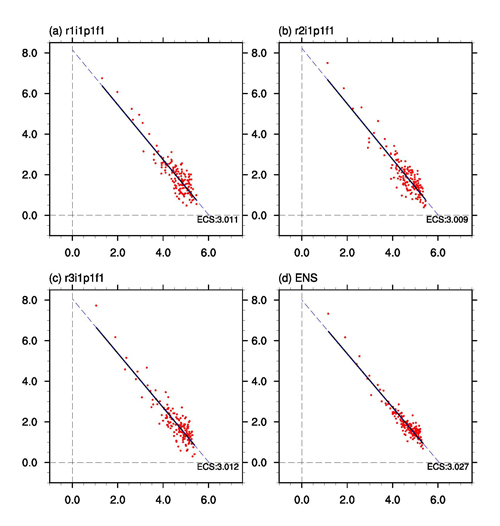AOSL: IAP Publishes CAS FGOALS-f3-L Model Datasets for CMIP6 DECK Experiments
Date:2020-07-15
The Diagnostic, Evaluation and Characterization of Klima (DECK) common experiments of phase 6 of the Coupled Model Intercomparison Project (CMIP6) are the baseline experiments for the model development. The Institute of Atmospheric Physics recently published the datasets of the Chinese Academy of Sciences (CAS) Flexible Global Ocean–Atmosphere–Land System (FGOALS-f3-L) model for the CMIP6 DECK experiments in Atmospheric and Oceanic Science Letters.
The CAS FGOALS-f3-L model team submitted the piControl run with a near equilibrium ocean state for 561 model years, and 160-year integrations for three ensemble members of abrupt-4×CO2 and 1pctCO2, respectively.
"These experiments maintain continuity and help to retain the basic document characteristics of models across different phases of CMIP. The DECK experiments are the baseline experiments for most of the endorsed MIPs [model intercomparison projects] of CMIP6. These experiments evaluate the basic climate performance and climate sensitivity of the climate model, which helps to understand and reduce the model's uncertainty in the future climate prediction." says Dr. HE Bian, the lead author of the study.
The preliminary evaluation suggests that the CAS FGOALS-f3-L model can preserve the long-term stability well for a mean net radiation flux of 0.31 W m-2 at the top of the atmosphere, and a limited decreasing trend of -0.03 W m-2/100 yr. The global annual mean SST is 16.45°C for the 561-year mean, with an increase of 0.03°C/100 yr. The model captures the basic spatial patterns of climate-mean SST and precipitation, but still underestimates the SST over the warm pool. The coupled model mitigates the precipitation bias in the ITCZ compared with the results from CMIP5. Moreover, the model’s climate sensitivity represented by the equilibrium climate sensitivity has been reduced from 4.5°C in CMIP5 to 3.0°C in CMIP6.

Climate sensitivity of CAS FGOALS-f3-L estimated from the 160-year integrations from the abrupt-4×CO2 and associated piControl simulations. The abscissa is surface air temperature anomalies (°C) and the vertical axis is TOA net radiation anomalies (W m-2). The blue dashed lines are extrapolations of the regression lines. (a) r1i1p1f1; (b) r2i1p1f1; (c) r3i1p1f1; (d) ensemble mean.
"All these datasets contribute to the benchmark of model behaviors for the desired continuity of CMIP", concludes Dr. HE.
Citation: Bian HE, Yongqiang YU, Qing BAO, Pengfei LIN, Hailong LIU, Jinxiao LI, Lei WANG, et al. (2020) CAS FGOALS-f3-L model dataset descriptions for CMIP6 DECK experiments, Atmospheric and Oceanic Science Letters, 13(6), DOI: 10.1080/16742834.2020.1778419.
https://doi.org/10.1080/16742834.2020.1778419
Media contact: Ms. LIN Zheng, jennylin@mail.iap.ac.cn
